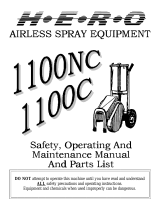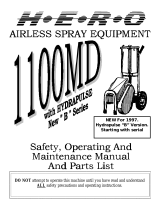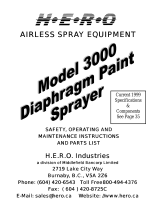Page is loading ...

Description:
Product ID/Stock No.:
For use with:
AIR VALVE KIT
62-9895-0009-5
3M
™
Scotch-Weld
™
Polyurethane Reactive Adhesive Applicator
3
Scotch-Weld
™
Polyurethane
Reactive Adhesive Applicator
Replacement Part
Installation Guide

- 1 -
1.
Disconnect air and electrical power and allow the
applicator to cool to room temperature before
disassembly.
Cut and discard the plastic tie wrap closest to the
applicator that holds the power cord and air hose
together.
Unscrew the endcap from the heat tube.
NOTE: If the endcap cannot be unscrewed, disassembly
may not be possible. Contact your Scotch-Weld
distributor for assistance.
2.
Pull one side of the wirestand out of the pivot hole (A)
and allow it to spring down into the recessed area (B).
NOTE: Do not attempt to pull the end completely out in this
step or binding may occur on the other side. For
best results, follow steps 2 and 3 to reduce possible
damage to wirestand or applicator.
Important Safety Instructions
Installation Guide
3.
Turn the applicator over and pull the other side of the
wirestand out of the other pivot hole and over the edge
of the applicator.
The wirestand can now be removed completely.
Save the wirestand for reassembly.
A
B
Disconnect air and electrical power and make sure applicator
has cooled to room temperature below servicing. Failure to
follow these precautions may cause electrical shock or burns.
!
WARNING
The service procedure shown in this installation guide should be
performed only by a qualified service person.
IMPORTANT
Refer to 3M™ Scotch-Weld™ Polyurethane Reactive Adhesive Applicator
User’s Manual for more information. Read the manual completely before
servicing the applicator.

- 2 -
4.
Remove the 12 screws that hold the housing halves
together and save them for reassembly.
NOTE: A long, magnetized Phillips bit (P2) is
recommended because it will pull screws out of the
deeper recesses.
If a non-magnetized bit is used, it may be necessary
to hold the housing halves together and turn the
applicator over to allow the screws to drop out.
It is recommended that all the screws be removed
before separating housings. This ensures that a
partially loosened screw will not cause problems in
steps 5 and 6.
5.
To make sure the upper housing will lift off cleanly,
just slightly separate the two halves at the location
shown.
Clear an area to the left of the applicator to allow both
housings to lie side by side.
HINT: To prevent the weight of the power cord and air hose
from pulling the applicator off the work surface, they
can be taped, tied, or put in a drawer just beneath the
work surface, if available.
6.
Hold the trigger and the air hose up into the upper
housing and lift off – at the same time flipping it over
so the interior is visible – and lay it next to the lower
housing.
NOTE: If adhesive contamination prevents separation of the
housings, contact your Scotch-Weld distributor for
assistance. Do not attempt to remove Scotch-Weld
adhesives with heat, flame, or solvent. This may
cause hazardous vapors or fire.
HINT: Position the endcap above the rear portion of the
applicator as shown so it will not interfere when laying
the upper housing down.
7.
If the front standoff (C) or the rear standoff (D) is
dislodged in any way, replace them on the heat tube
(E). Upper and lower sets of standoffs should be in
contact with no visible gaps between them at all four
locations (F).
C
E
F
D

8.
Unscrew the endcap from the quick dump valve by
holding fitting (A) and turning in the direction as shown.
Unscrew the quick dump valve from the endcap air hose.
Unless you are also replacing the quick dump valve or
the endcap, save both for reassembly.
- 3 -
11.
Pull the tapered locking pin out of the air hose strain
relief (C).
Save the pin for reassembly.
9.
Pull the valve (B) out of the upper housing by lifting
the tubing out of the notched ribs and lifting up on the
trigger.
B
A
10.
Use a 1/4 in. open end wrench and remove the brass
fitting that connects the air supply tubing to the valve.
Discard the faulty valve
NOTE: A needle-nosed locking pliers is recommended for
this procedure. It will hold the pin securely and the
pin can be left in the locking pliers in proper position
for reassembly.
IMPORTANT: Remove any loose pieces of thread sealent
tape and any other foreign material from the
threaded inlet to the quick dump valve.
7/16 in.
(11 mm)
7/16 in.
(11 mm)
1/2 in.
(13 mm)
C

- 4 -
15.
Insert the tubing end of the endcap air hose through
the opening in the housing.
Hold the fitting in position on the valve and twist the
endcap air hose to screw the fitting to the valve.
Tighten the fitting with 1/4 in. open end wrench.
14.
Attach the quick dump valve from step 8 to the
replacement air hose.
12.
Squeeze the upper and lower parts of the strain relief
together and at the same time, pull it out of the housing.
Discard the hose and all connected fittings and strain
relief.
13.
Attach the replacement air valve to the air supply
tubing by screwing the valve on the fitting.
Tighten the fitting with 1/4 in. open end wrench.
IMPORTANT: Tighten the fitting firmly, but do not use
excessive torque. The rubber sealing
washer could be damaged if the fitting is
overtightened.
IMPORTANT: Make sure the inlet in the quick dump valve is
free from foreign material. Debris that could
enter the quick dump valve may cause
adhesive run-on during applicator operation.
7/16 in.
(11 mm)
1/2 in.
(13 mm)
IMPORTANT: Tighten the fitting firmly, but do not use
excessive torque. The rubber sealing
washer could be damaged if the fitting is
overtightened.

- 5 -
16.
Position the strain relief so that it is about 1/2 in (12.7
mm) from the hose fitting as shown.
Rotate the strain relief so the hole (B) is toward the top
of the applicator housing.
Squeeze the strain relief together and push it into the
opening in the housing until it snaps into place.
Pull the hose back through the strain relief until it
resists further movement. There will be approximately
1/8 in. (3.2 mm) between the strain relief and the hose
fitting when in proper position.
17.
Twist the endcap hose so the quick dump valve will lie
flat on the work surface and fitting (A) will be directed
straight down the center of the housing when the hose
is bent up into the position shown above.
A
18.
Push the smaller diameter end of the tapered locking
pin into the hole in the strain relief.
Push the pin through the strain relief until the small
end rests in the recessed area (C) as shown.
NOTE: A needle-nosed locking pliers is recommended for
this procedure. It will hold the pin securely and allow
you to guide the pin through the strain relief more
easily.
19.
Place the valve in position and press the tubing down
into the grooved ribs as shown. The tubing on the
replacement air supply line should be underneath the
tubing that connects to the endcap.
Engage the trigger (D) on the valve button (E) and
position the trigger into its bearing.
When properly positioned, the top flat of the
hexagonal valve body will be horizontal and the tube
fittings will be directed away from you and down
along the inside surface of the housing.
D
E
1/2 in.
B
C

- 6 -
21.
Hold trigger and the air hose in position in the upper
housing and lift and turn the upper housing over onto
the lower housing. Crossing the hands as shown will
make it easier to hold the components in position
while turning the housing over.
Make sure both housings are aligned and press them
together.
Attach one housing screw along the top of the
applicator where shown, but do not fully tighten. This
will hold the housing halves together during final
adjustment of power cord and air hose.
NOTE: You should feel a definite engagement when the
housing halves mate properly. If not, lift the upper
housing off – as in step 6 – and check for components
that might be out of position. Repeat steps 15 and 16.
22.
Separate the housing halves at the bottom of the
handle just enough to adjust the position of the power
cord strain relief. The hex (H) should be aligned and
fully engaged with the matching hex-shaped recess
in the housings. If necessary, rotate the strain relief
hex one flat in either direction to obtain good fit.
If necessary, adjust the position of the air supply hose
so it is located properly in the circular recesses.
While holding the housings halves together, insert a
housing screw into the lowest hole and tighten just
snugly.
23.
Recheck proper fit and alignment between the
housing halves and make sure the trigger pivots
freely.
Insert the other 10 housing screws and tighten all the
screws firmly but not too tightly.
IMPORTANT: Do not use a large screwdriver or a power
driver at a high torque setting. Overtightening
the housing screws could cause the threads
to strip out and damage the lower housing.
H
20.
Check the locations indicated by arrows above to
make sure all components are positioned properly.
Wires at E1 and E2 should be down into positions so
the upper housing and air valve will not pinch them
during reassembly.
Air tubing at A1, A2 and A3 should be positioned in
grooved ribs so the valve will be held in position.
A3
A1
A2
E1
E2

3
Industrial Business
Industrial Adhesives and Tapes Division
3M Center, Building 220-5E-06
St. Paul, MN 55144-1000
Printed in U.S.A.
©3M 2005 78-6900-7023-6 (1/05)
Recycled Paper
40% pre-consumer
10% post-consumer
LIMITED WARRANTY: 3M warrants for a period of 30 days from the date of purchase or use, whichever occurs first, that the
3M™ Scotch-Weld™ AIR VALVE KIT will be free of defects in material and manufacture. 3M MAKES NO OTHER WARRANTIES,
EXPRESS OR IMPLIED, WITH RESPECT TO THE SCOTCH-WELD AIR VALVE KIT INCLUDING, BUT NOT LIMITED TO, ANY
IMPLIED WARRANTY OF MERCHANTABILITY OR FITNESS FOR A PARTICULAR PURPOSE. This limited warranty does not cover
damage resulting from accident, misuse or abuse, lack of reasonable care, service performed by an unauthorized repair service, use of
unauthorized replacement parts, operation or maintenance not in accordance with 3M recommended procedures, or the use of
adhesive cartridges not manufactured by 3M or not subject to 3M finished product standards.
LIMITATION OF REMEDIES: If the Scotch-Weld AIR VALVE KIT is proved to be defective within the warranty period stated above.
THE EXCLUSIVE REMEDY AND SOLE OBLIGATION OF 3M SHALL BE, AT 3M’S OPTION, THE REFUND OF THE PURCHASE
PRICE, REPAIR OR REPLACEMENT OF THE DEFECTIVE SCOTCH-WELD AIR VALVE KIT.
LIMITATION OF LIABILITY: Except for the exclusive remedy stated above, 3M shall not otherwise be liable for any loss or damages,
whether direct, indirect, special, incidental, or consequential, regardless of the legal theory asserted, including negligence, warranty, or
strict liability.
24.
Hold the wirestand so the rounded part (C) curves
away from the applicator and temporarily hook one
end of the wirestand so the end rests down in the
bottom of the recess (B) as shown.
25.
Pull the other end of the wirestand just enough to go
over the edge of the applicator and position it into
the pivot hole (A). The spring action of the wirestand
will pull itself down into place.
26.
Pull the first end of the wirestand – from step 24 –
out of the recess and position it over its pivot hole.
The spring action of the wirestand will pull itself
down into place.
C
B
A
27.
Reattach endcap to quick dump valve by holding
fitting with wrench and turning endcap in direction
shown.
IMPORTANT: Overtightening may cause the fitting to bind
and prevent free rotation of the endcap.
Loosen the fitting slightly if endcap does not
rotate freely.
/



